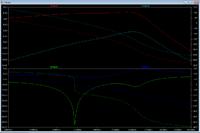mtwieg
Advanced Member level 6
I'm trying to simulate a 128MHz 900W class AB PA described in this application note (and also the **broken link removed**). The only model microsemi gives for the device is a SPICE subcircuit based on a DMOS model, so I'm working with that in LTspice.

As shown above, I'm able to get a S11 match on the input by following the described tuning procedure, but something is wrong. My S21 is only around 6dB and my |S22| is greater than unity (though strangely I haven't seen any instability during transient simulations). S12 is also very poor. I'm pretty sure my simulation doesn't leave out anything important, but no amount of adjustment to the design parameters seems to solve these issues. I feel I'm either modelling the TLTs wrong, or there's something wrong with the device model itself (when I simulate its characteristic curves they come out pretty different from those in the datasheet).
Here is a pdf schematic of the simulation schematic, and a zip files with all the simulation files. Any help would be appreciated.
View attachment PA1.pdf
View attachment arf475 PA.zip

As shown above, I'm able to get a S11 match on the input by following the described tuning procedure, but something is wrong. My S21 is only around 6dB and my |S22| is greater than unity (though strangely I haven't seen any instability during transient simulations). S12 is also very poor. I'm pretty sure my simulation doesn't leave out anything important, but no amount of adjustment to the design parameters seems to solve these issues. I feel I'm either modelling the TLTs wrong, or there's something wrong with the device model itself (when I simulate its characteristic curves they come out pretty different from those in the datasheet).
Here is a pdf schematic of the simulation schematic, and a zip files with all the simulation files. Any help would be appreciated.
View attachment PA1.pdf
View attachment arf475 PA.zip